
Mercadux - Level Design Document
This document will serve as the basis for the Level Design documentation of the game "Mercadux."
The purpose of this document is to provide a clear overview of the game and guide the areas of art and game design, thus facilitating a better understanding of the objectives of each level for both the player and the developers.
Overview
One of the most dreaded moments in almost all occurrences of going to the market is waiting in line; nobody likes to be last. And getting to the checkout before everyone else, especially with the shopping list complete, is the best feeling.
"Mercadux" is a game that takes competitiveness to the extreme, and this is clearly represented in the most classic way known to humanity: throwing a carton of eggs at the person trying to beat you to the checkout.
Inspired by games like "Overcooked," "Mario Party," and "Fall Guys," Mercadux aims to bring chaos and competitiveness into the supermarket, but with a more Low Poly and fun style.
Player Focus
The player's focus is to complete their shopping list before all opponents, avoid potential sabotage, and reach the checkout to finalize their purchases. Each action of the player is converted into points, and upon reaching a certain number of points, they win the championship.
Disclaimer: Mercadux was developed as the final project for the Postgraduate Course in Digital Game Development at the PUC-RS.
For this reason, it only has 2 levels. However, the possibilities to expand this game and turn it into a successful party game are endless.
For this reason, it only has 2 levels. However, the possibilities to expand this game and turn it into a successful party game are endless.
1.0.0 | Information and Layout Rules
1.1.0 | Intro Level
When we started developing Mercadux, the aesthetic we were initially aiming for was much closer to a conventional market, which aligned more with a simulation game rather than the competitive (party game).
After a few weeks of development, I decided to suggest a different art direction for the game, bringing in a more playful aesthetic. This allowed us to work on a more engaging level design.

Mercadux Greyboxing | June/21 (by Marcelo Froes)

Built Gold Version | Dec/21
With this new artistic direction was possible to sectorize the spaces based on colors, and thereby help the player to locate themselves in Mercadux and find the items on their shopping list more easily.
1.2.0 | Zones
1.2.1 | Green Fields & Organic Trees


The green fields come with the concept of linearity and parallelism, always ensuring that the player progresses.
They are narrower spaces, but never suffocating. In them, it is possible to find canned and packaged products.

In the depths of the "Green Fields" it's always possible to break the pattern and prevent monotony with the "Organic Trees", which are visual elements to help the player navigate more quickly.
They serve as visual landmarks in the level design. However, it's not just visually and spatially that these elements break the flow of the "Green Fields".
The products found in these trees are the finest selection of fruits and vegetables, which, besides being delicious, are giant in their proportions, drawing even more attention to those who need to complete a certain shopping list.

Rules:
1. They "Green Fields" should be long corridors with alternating interruptions, resembling the roots of a large tree.
2. Always used in conjunction with the "Organic Trees" and work on breaking pacing with both elements.
3. There should always be an entrance and an exit.
2. Always used in conjunction with the "Organic Trees" and work on breaking pacing with both elements.
3. There should always be an entrance and an exit.
1.2.2 | Blocky Yellows


The name of this space is not in vain. The "Blocky Yellows" are areas that would make any organization and cleanliness maniac proud. They are enclosed circuits, little boxes that fit together, spreading across the walls only when it makes sense for the composition of a space.
In them, it is possible to find everything related to cleanliness and personal hygiene, making them the most straightforward spaces in the market.

Rules:
1. They can be used as transitional moments between colors or to break in overly extensive monochromatic areas.
2. Use walls only when necessary; otherwise, prefer to use them in situations away from them.
3. They need to show clear circulation through them.
1. They can be used as transitional moments between colors or to break in overly extensive monochromatic areas.
2. Use walls only when necessary; otherwise, prefer to use them in situations away from them.
3. They need to show clear circulation through them.
1.2.3 | Blue Labyrinth


Don't loose yourself!
The "Blue Labyrinths", although simple, can have various paths leading to the same point, making confrontation with other opponents inevitable and often turning those exhausting escapes into frustrating dead ends.
On the other hand, whether fleeing or pursuing someone, it's always important to stay hydrated, and here is the section for beverages:
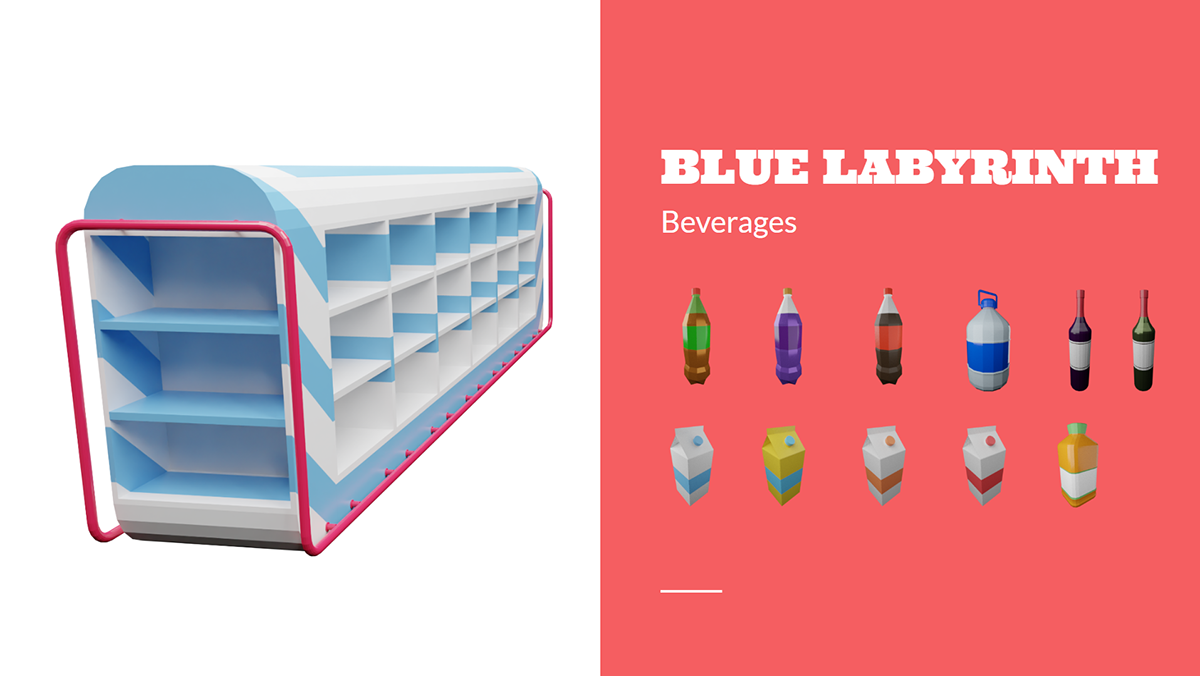
Rules:
1. They are generally more elaborate and treacherous zones.
2. Provide various ways to create interaction between players.
3. "Dead ends" are welcome alternatives, but it's always important to have a reason for them.
1.2.4 | Freezer


Not all heroes wear capes, but these beauties here need a tightly closed door to ensure that their products are saved from melting. With a unique mechanic attached to their use, every time a player opens the freezer door, the next player will have a little more difficulty opening it subsequently, creating an incredible race against time.
Usually found on walls, these equipments contain products that require care:
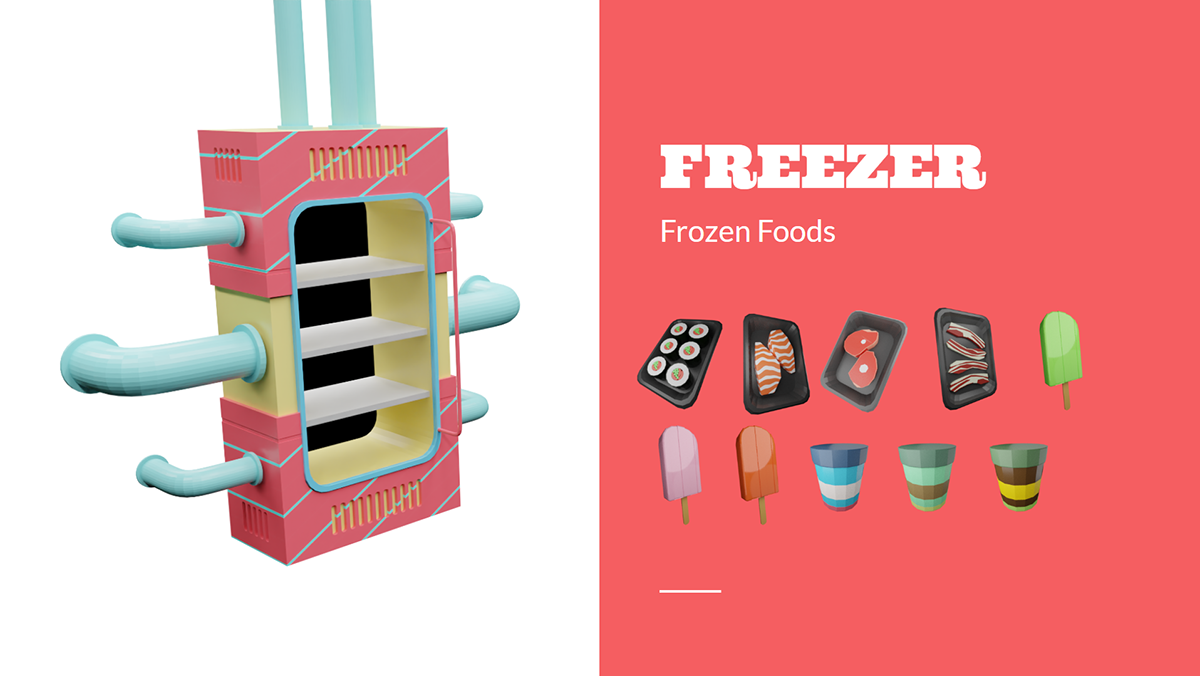
Rules:
1. They adapt well to any zone but tend to stay away from the "Baked Goods Factory."
2. They typically are placed on walls, forming zoned perimeter.
1.2.5 | Baked Goods Factory


Don't blink, or you might miss a freshly baked snack coming out of the oven.
Unlike the furniture presented so far, the ovens of the "Baked Goods Factory" have a conveyor belt that never stops, and to discover what's coming next, just look at the small screens above the curtain.
With a wide variety of products, these conveyor belts are fast, requiring the player to stay alert to what's coming from all sides, or else they might end up eating cake.
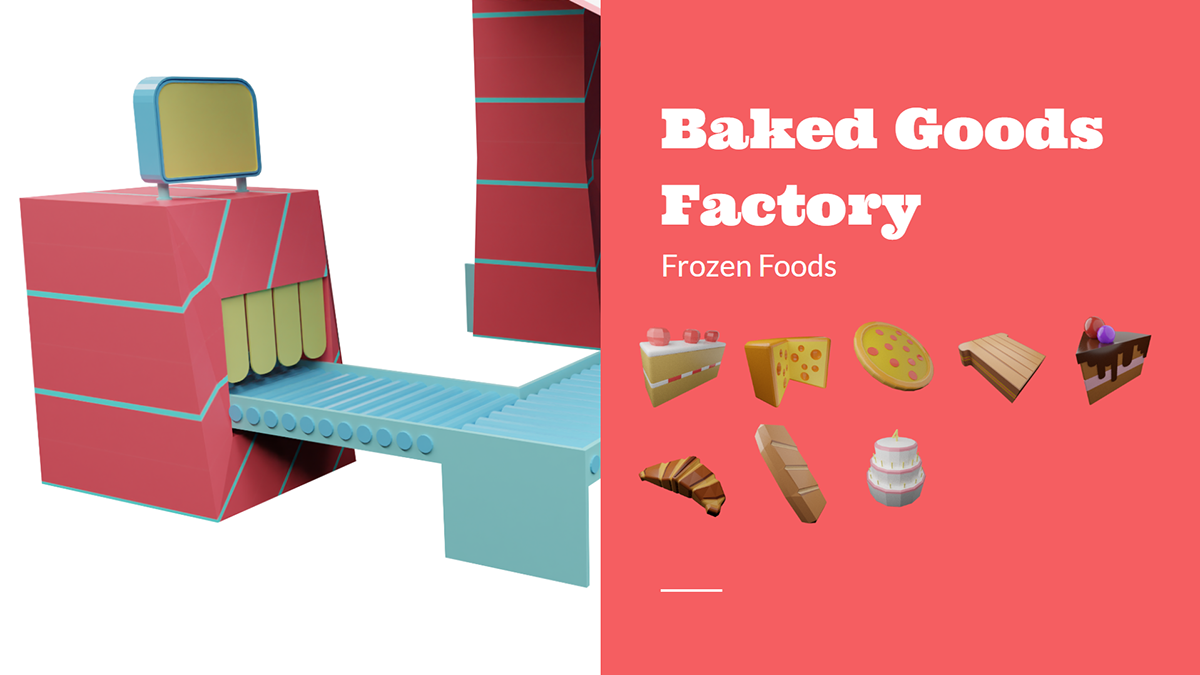
Rules:
1. They work best with large open areas.
2. They can spread throughout the level in unusual ways and even climb walls.
2.0.0 | Level 1 - Welcome do Mercadux
2.1.0 | Overview
The level "Welcome to Mercadux" comes with the prerogative of showcasing the universe of this supermarket, which is unlike anything that has ever existed.
Its area is smaller, allowing the player to spend more time getting familiar with the location of products and understanding how the gameplay works, rather than risking getting lost in the midst of endless shelves.


The bubble diagram was created to illustrate a hierarchy of zones and thus position where the areas of greatest importance of this level and zones of interest to the player should be.
As a design decision, it was established that the player will always start the level from outside Mercadux.
Therefore, the checkouts were intentionally placed as the first element the player sees, creating familiarity with the final objective of the level, right after, a sequence of different zones is presented, allowing the player to voluntarily traverse them until they find all the products on their list.
2.2.0 | Players Focus
The player's focus is the main objective of the game:
- Completing their shopping list and reaching the checkout.
2.3.0 | Level Objectives
1. Mark the player's first sight on the checkout.
2. Make the player familiar with the different colors and possible products placed in each zone.
3. Short and simple level, allowing the player not to get lost easily.
2. Make the player familiar with the different colors and possible products placed in each zone.
3. Short and simple level, allowing the player not to get lost easily.
2.4.0 | Zones and Layout
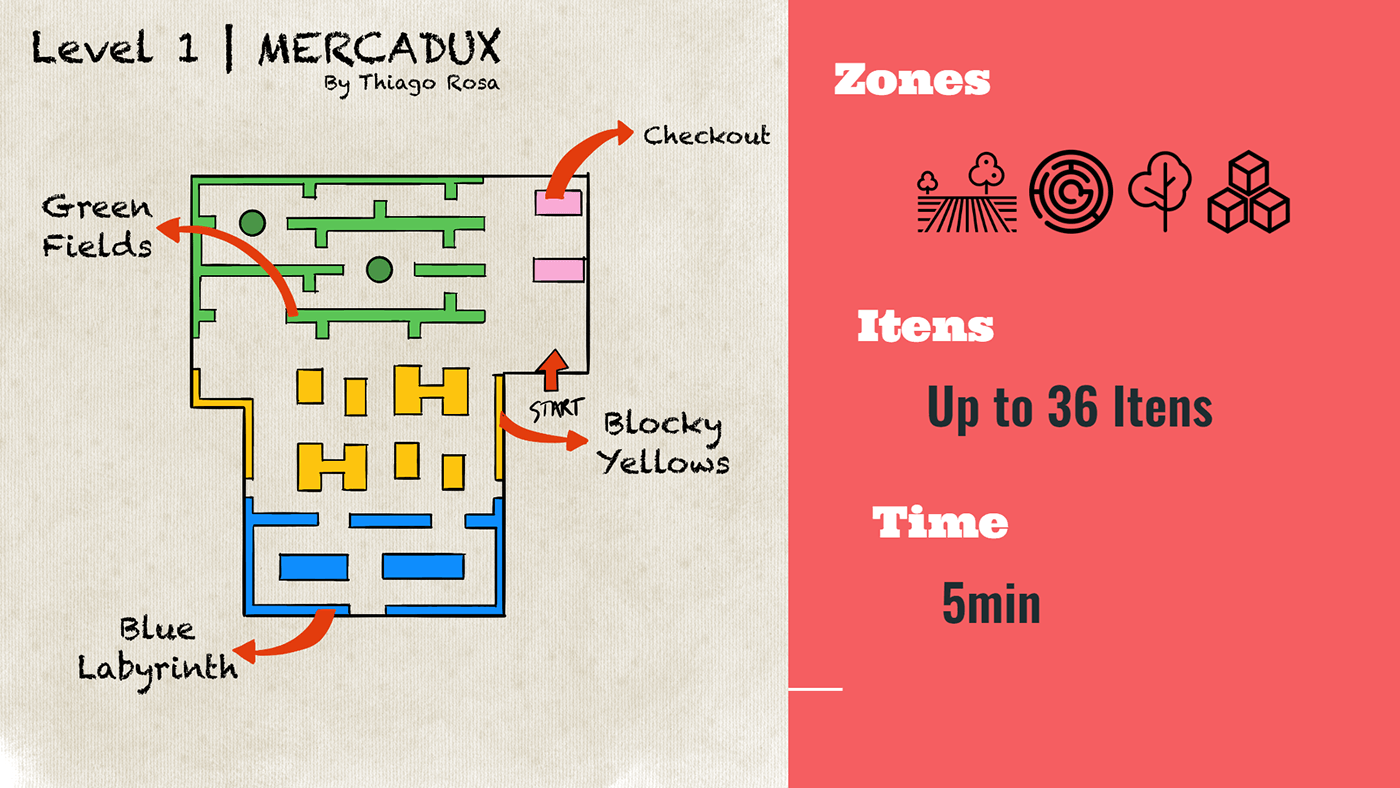




3.0.0 | Level 2 - Ice and Fire
3.1.0 | Overview
The level "Ice and Fire" is a clear continuation of "Welcome to Mercadux", introducing 2 new areas: the "Freezers" and the "Baked Goods Factory," with new mechanics for players to explore.
This level is larger and more robust, bringing a few new challenges for the players.
All zones have increased in size, and it's now possible to understand more about the guidelines I addressed before, such as the linearity of the "Green Fields," the pattern-breaking aspect that the "Organic Trees" bring to their zone, etc.


The almost symmetrical layout of the level gives the player a good sense of location, but this is where the "Blue Labyrinth" shines. Taking advantage of the level's width and depth, it's possible to create dead-end paths and various alternative routes to lead the players to "Baked Goods Factory."
I choose to place the checkout near the entrance of the level again to encourage players to explore more of the depth in this level and thus provide a more present confrontation between players.
Another design decision in this level was to place the two new zones in opposite directions, allowing each of them to generate the "wow factor" individually and not overwhelming the player with too many new features presented at once.
3.2.0 | Level Obectives
1. Introducing two new areas to the player, and consequently, 18 new products.
2. Training strategic placements and risky movements.
3. Reaffirming color schemes and products.
2. Training strategic placements and risky movements.
3. Reaffirming color schemes and products.
3.3.0 | New Mechanics
Freezer: The freezer area isn't just an aesthetic novelty. We decided to introduce a mechanic that makes constant access to its products more difficult by applying extra pressure on the doors each time the players open them, creating a sense of urgency and anxiety to grab the items while also managing your shopping cart.
Baked Goods Factory: Unlike the freezers, the magical ovens of "Mercadux" don't come with any obstacles for the player to retrieve the desired product, unless they take too long to come out of the oven.
On a continuous conveyor belt, all 8 new products will be randomly spawned. This means that the player's list item may be readily available or take some time to come out.
Patience and attention are key in this bakery area.
3.4.0 | Zones and Layout
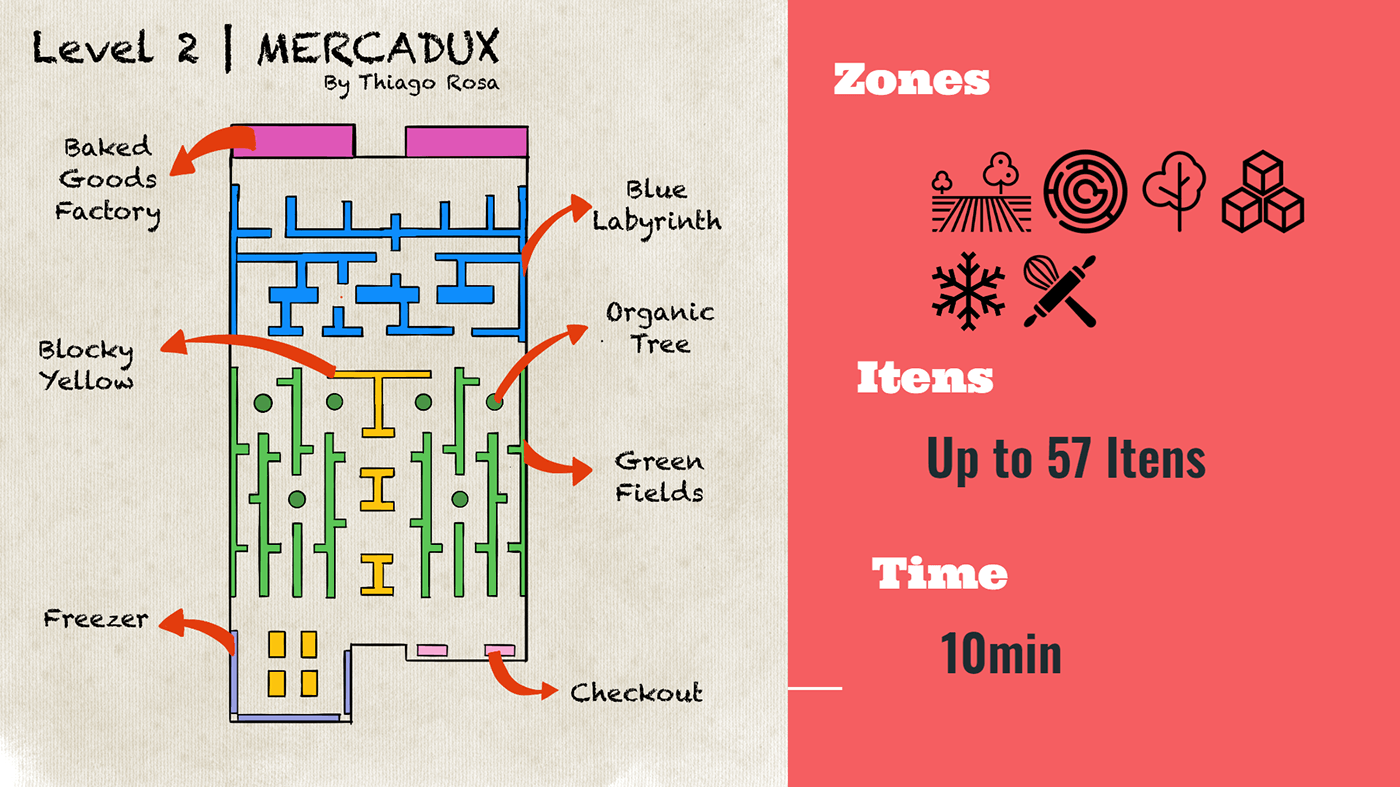




4.0.0 | New Mercadux Level Updates
4.1.0 | Tiles
With the game delivered and released, we briefly resumed its development and began to explore other solutions for Level Design that would bring improvements to the game.
The first idea was to create a tile system with directional arrows, where the player could understand from these arrows which direction they should go and from which direction they came:






I also decided to implement colored tiles in these product areas to create a more didactic way for the player to understand where they were and to prevent them from getting lost.
These tiles bring complementary colors to their zones, giving greater emphasis to the idea of "dissolving", creating a notion of how much within a zone the player is; the more the floor would be colored and the more fragmented these colored floors would be towards the outside of that area:






Along with this, we tested at blockage stage tiles that would highlight an area, bringing immediate importance to that zone.
These blockages consisted of:
1. Ice Tiles for the Freezer area, where we could implement a sliding mechanic in the future (a very common solution in games where the character walks on ice and the friction is momentarily altered).
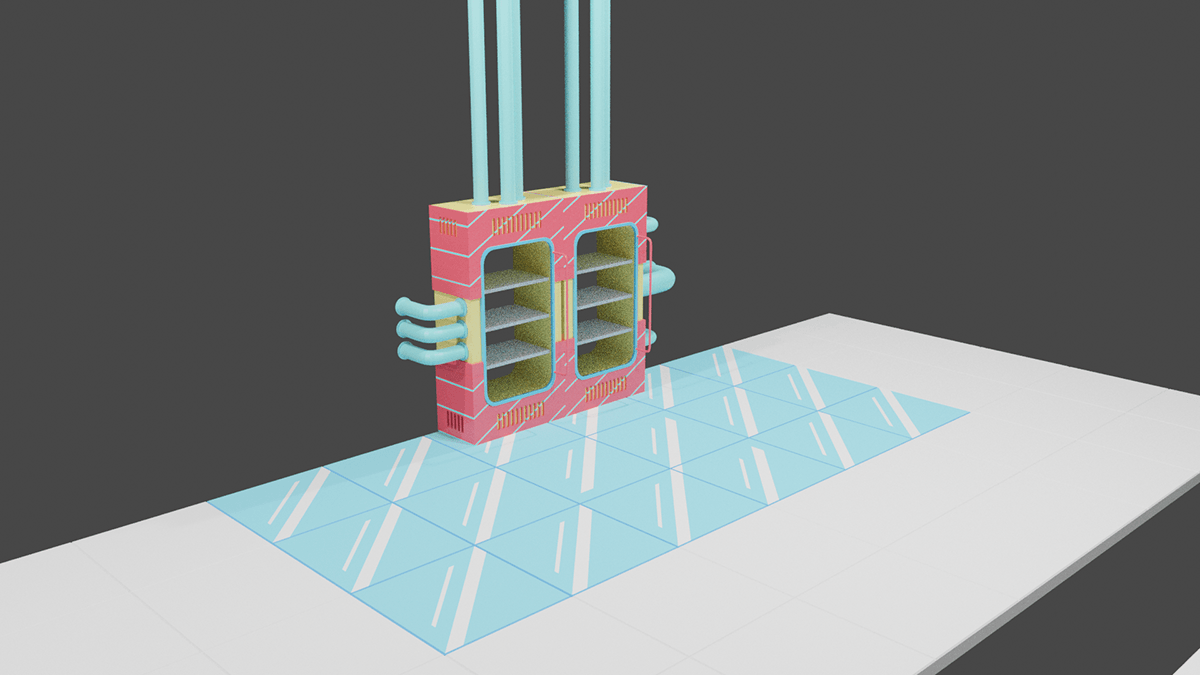
2. Highlight Tiles for the Checkout area and/or items where we could potentially implement the "power-up" mechanic in the game.





4.2.0 | Colors
After testing the tiles, I conducted some color tests as well, emphasizing the pipes on the shelves, making them stand out more and eliminating the white previously present in the body of these same assets.
So the game would be more colorful and closer to the references we brought at the beginning of the project's development.



4.3.0 | Conveyor belt (Baked Goods Factory)
Another proposed improvement that was considered is to make the "Baked Goods Factory" a more present zone in the level, using its conveyors in a more boldly constructive way, suggesting interesting visual points to the player.
For example, from the beginning of the level the player can see these conveyors on the ceiling of the market with products passing by, but it's only at certain points in the market where it's actually possible to grab the products, creating a sense of curiosity towards these areas through visualy appealing elements.
This would even open doors to play with the game's gravity and use these conveyors as means of transportation for the player to areas that were previously unreachable.


5.0.0 | Conclusion
In conclusion, the Level Design of Mercadux has always been in constant change to further enhance the player's experience and comfort, striving to bring elements that make navigation through its levels coherent and smooth.
With the creation of colored elements and assigning them specific roles, it was possible to create a kind of "biome" corresponding to each zone of the supermarket, thus bringing familiarity to the player. With this, it's possible to understand that the need for elements on floors and ceilings can indeed be an alternative to further improve gameplay without burdening the game with unnecessary information.
Mercadux is a game with great potential to explore different levels and mechanics, and its coherent distancing from reality makes it even more fun to play with the possibilities.
If you've made it this far, thank you very much, and it would be a pleasure to hear feedback on the game or this documentation.
Link to download and play Mercadux:
https://ofroes.itch.io/mercadux
https://ofroes.itch.io/mercadux

